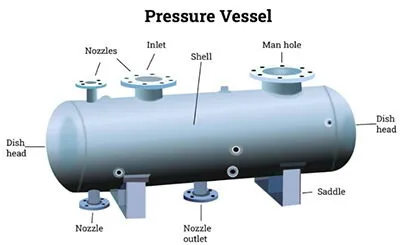Essential Safety Design Principles for Pressure Vessels
On this page
Pressure vessels are essential equipment widely used in the chemical, oil, and energy industries. Their safe design directly impacts the safety of both personnel and equipment. Safety design encompasses every aspect from design and manufacturing to usage, and a reasonable design philosophy can effectively reduce the risk of accidents. This article focuses on the safety design of pressure vessels, discussing key aspects such as the strength requirements for pressure-bearing components, thermal expansion limitations, cooling system design, shape and structural optimization, welding considerations, and non-destructive testing.
Strength Requirements for Pressure-Bearing Components
Pressure-bearing components are critical parts of pressure vessels, and their strength design must meet the pressure and temperature requirements during use. In safety design, it's essential first to select suitable materials that offer good mechanical properties and corrosion resistance. Additionally, the structure of these components should minimize stress concentration. Advanced techniques like finite element analysis can be used during the design process to optimize the shape and thickness of components, ensuring sufficient strength and stiffness.

1. Material Selection
Material selection is crucial and should be based on the nature of the working medium, as well as the temperature and pressure conditions. Commonly used materials include carbon steel, stainless steel, and alloy steel, all of which can maintain good performance under high pressure and temperature.
2. Strength Calculations
When calculating strength, both static and dynamic loads should be considered. Standard calculation methods ensure that all parts can withstand the maximum working pressure. Additionally, safety factors are typically set based on national standards and industry norms.
Limitations of Thermal Expansion
During operation, pressure vessels can experience thermal expansion due to temperature changes. To prevent thermal stress, the design must allow unrestricted expansion and contraction of heated components.
Design Measures
To achieve this, appropriate expansion joints and support devices should be used in the design. These devices can effectively absorb the deformation caused by thermal expansion, preventing internal stress. Furthermore, the layout of fixed and support points in piping should be reasonable to allow heated components to move freely during expansion, avoiding damage from external constraints.
Reliable Cooling System
In high-temperature conditions, designing a reliable cooling system is critical. An effective cooling system can significantly reduce the internal temperature of the pressure vessel, preventing safety hazards caused by overheating.
Cooling System Design
The cooling system should be designed according to working conditions, including the flow rate, temperature, and pressure of the cooling medium. It is important to ensure that the cooling medium can uniformly cover the heated components, avoiding cooling blind spots. Regular inspection and maintenance of the cooling system are also necessary to ensure its effectiveness and reliability, preventing accidents due to insufficient cooling.
Shape and Structural Optimization
The shape and structural design of pressure vessels are key factors in ensuring safety. The design should avoid discontinuous geometries to reduce local stress concentrations.
1. Smooth Transitions
The geometry of the pressure-bearing shell should be as smooth as possible, avoiding sharp corners and protrusions. The design should incorporate a gradient transition concept to ensure even stress distribution and enhance overall structural strength.
2. Staggered Design
When designing, ensure that structures with high local stress, such as openings, corners, and weld seams, are staggered in position to prevent stress accumulation, thereby reducing the risk of failure.
Welding Structure Considerations
Welding is an unavoidable aspect of pressure vessel manufacturing, but improper welding design can lead to stress concentration and a decrease in material performance.
1. Welding Techniques
During welding, appropriate preheating and post-weld heat treatment should be implemented to reduce the impact of welding stresses on the structure. The design of weld joints should also consider deformation during welding to ensure a good bond between the weld and the base material, thereby lowering the risks of fatigue and brittle fracture.
2. Weld Inspection
The quality of welds directly affects the safety of pressure vessels. The design should incorporate non-destructive testing of welds to ensure there are no defects during welding. Regular non-destructive testing can help identify and address welding defects in a timely manner, ensuring the safe operation of the pressure vessel.
Design Considerations for Non-Destructive Testing
Ensuring the feasibility of non-destructive testing during the manufacturing and use of pressure vessels is a critical safety measure.
1. Testing Methods
Adequate access points and inspection channels should be designed to facilitate non-destructive testing. Common non-destructive testing methods include ultrasonic testing, radiographic testing, and magnetic particle testing, all of which can effectively identify internal and surface defects in materials.
2. Regular Maintenance
Additionally, a regular inspection and maintenance system should be established to ensure the long-term safety of pressure vessels. Periodic non-destructive testing and maintenance can help uncover potential hazards and take timely measures to prevent accidents.
Conclusion
The safety design of pressure vessels is fundamental to ensuring their safe operation. By reasonably designing pressure-bearing components, allowing for unrestricted thermal expansion, establishing reliable cooling systems, optimizing shape and structure, and considering welding and non-destructive testing, the risks associated with the use of pressure vessels can be effectively reduced. Strengthening the design, manufacturing, and maintenance management of pressure vessels is a crucial measure for ensuring industrial safety. Achieving excellence in all aspects is essential to maximize the safety and reliability of pressure vessels.

